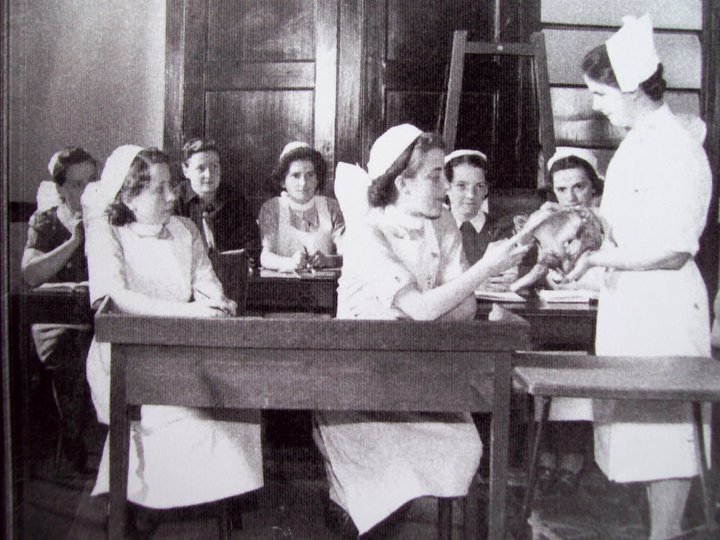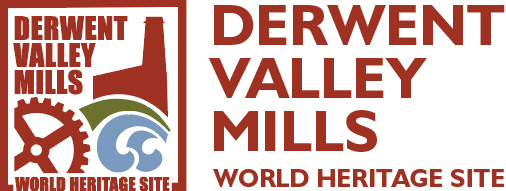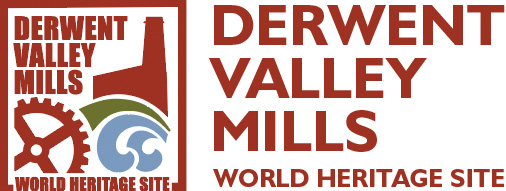Midwife Training and Duties

Throughout the second world war thousands of young women from all parts of Britain, chose to train as nurses and midwives to help the war effort. For many it meant leaving their hometowns to move to large cities. Barbara Haywood, (nee Pearce) was one of those, who by coincidence was born less than two miles from Willersley Castle, in the tiny hamlet of Bolehill, close to Wirksworth and went to school in Middleton Village.
Her daughter, Diane Walker, a retired mobile librarian, who still lives locally, said her mother was bright enough to take the 11+ and go to Wirksworth Grammar School, but turned it down as she was too shy to go down into Wirksworth and felt intimidated by the teachers who wore gowns. Instead, she went into service where she gained valuable caring experience with children. The start of the war brought a momentous change for Barbara as she moved to London on her own to undertake training as a nurse and midwife at the Mothers Hospital and recalled being sent out on her bicycle during blackouts to visit mothers.
She was evacuated to Willersley in 1942 where she continued her midwife training and stayed in the area after the war to become a district midwife for Derbyshire Dales and a mother.
As a district midwife Barbara sometimes had to do shifts in the new local maternity units such as Waltham House in Wirksworth and in Darley Hall (Whitworth Hospital), but preferred home deliveries. In the units she spent a lot of time taking babies to mothers for feeding as the babies were kept in a nursey and had to ensure they had the right baby! She said she worked hard despite the low wage and often didn’t have time for toilet breaks! She liked the autonomy of being a district midwife even though it meant delivering babies in remote rural villages such as Parwich, on farms with muddy yards and over the years enjoyed getting to know the families.
Trainee Midwife Winifred Warren, nee Clough, remembered at the first reunion that there was a fresh intake of trainees every three months, and a group photo was taken as each batch was ready to leave, and didn’t include the new intakes.
Girls with no previous training as a nurse did a two-year course, then went straight into midwifery. But those with nursing experience did a six-month course and could then either leave with a first certificate of the Central Midwives Board or do a further six months to become a State Certified Midwife. Anyone becoming a State Certified Midwife was required to work as a midwife for a further twelve months which was useful for those going into District Nursing, which Winifred and Barbara Haywood did.
Beatrice, a trainee midwife from Norwich wrote a thank you letter to one of the Willersley Babies reunion organisers and Salvation officer, Mr Stuart Snowball, of her memories at Willersley.
‘I left school at the age of 17 and had to wait until I was 18yrs to commence my General Nursing Training in London. My parents were Salvation Army Officers and it was suggested in 1942 that I went to the Mothers Hospital for experience with newly born babies.
‘The air-raids had been and were still taking place and I was quite pleased to get away with London expectant mothers when they were evacuated to Willersley Castle in Derbyshire from London. I think it was September of that year when I met staff in charge of a crowd of pregnant ladies on the platform of Waterloo Station.’
‘The carriages were reserved for us with a corridor adjoining, on route to Derby. We served milk and other refreshments to the patients. When one of them called “Nurse” – I looked around for a nurse and suddenly realised someone was talking to me! Private coaches were waiting in Derby Station for us and the journey meant taking mums to their various billets before reaching the Castle.
‘After delivery, the babies were not left at the mothers’ bedsides because it was believed that they, the mothers, needed to rest, undisturbed by the babies crying! I have memories of a beautiful nursey with about 30 swinging cots, tastefully lined and prepared for the new additions on night duty, surrounded by these babies it was very soporific when sitting feeding the very small infants!
‘The grounds, sloping down to a river were attractive and it was an idyllic place to be for 6 months whilst the war continued. I eventually returned to The Mothers Hospital and commenced taking mothers and babies to the air-raid shelters every evening, for the night. What a contrast!’
Photos of Kathleen Bateman as a young midwife and aged 96 in 2019 in the Hackney Gazette, London.
Another midwife who started her training at the Mothers, to be evacuated just two months later to Willersley Castle, was Kathleen Bateman who was interviewed by Heidi Luker in 2020 as part of the project aged 97 and previously by journalist, and great cousin Kim Wells for the Hackney Gazette in 2019.
“When the bombings happened, the porters would have to take us all down to the cellars – babies and all,” said Kathleen who lives in Manchester. “The babies would be wrapped up in blankets and put on shelves. And if someone was in labour you couldn’t go down; you just had to stay on the grounds and hope for the best.”
“It was a small-ish hospital,” said Kathleen. “You arrived on your first day and the home sister took you up to your room, put your uniform on the bed and sort of said ‘get on with it’.”
“I was doing what you might call gynaecology now, looking after the women before and after. Women would be in hospital for about 10 days around their pregnancy, and they would stay in bed for that time.”
“We were one of the first maternity hospitals to get mothers up and about – partly to get them down to the air raid shelters, I imagine.”
“We would do bedpan rounds and go round with a swabbing trolley with Dettol in it, washing their backs so they didn’t get bed sores. It was important work, as antibiotics weren’t available at that time.”
Kathleen had moved to London from Manchester to complete six months’ training in maternity nursing. Having nursed D-Day soldiers, and those industrially wounded, in Altrincham, she chose to continue her training at the Mothers’ Hospital.
“It was so unusual back in those days for anyone to be sympathetic about unmarried mothers, but it just seemed to strike a chord with me,” she said. “I thought: ‘No one is looking after these mothers’. So I applied to go to London.”
Although she should have gone to Queen Charlotte’s in London, someone went to great lengths to accommodate her wish to train at The Mothers’ Hospital.
“I was a bit shocked at first, because part of the set-up was that mothers in the last stages of their pregnancy were actually scrubbing the concrete steps, earning their keep, if you like. Well, it must have done them some good, as we never lost a mother in all the time I was there.”
Two months later, Kathleen was evacuated up to Willerlsey Castle when devastating V1 and V2 “buzz bombs” started to fall on London.
“We had had bombs the whole time I was there, but when the V2s came, the whole hospital would have gone. The craters were so huge. The first had fallen near Kew, but once it began, they were falling all over the place, so we had to be evacuated. The thing about those V2 bombs was that you heard it coming. It went “chug-chug-chug-chug-chug” in the sky and you just found yourself just hoping it would keep chugging past you, because once it stopped, it dropped. And you were just holding your breath.
“It’s surprising in old age. Some of these things come back more clearly than what you did last week. It was quite an intensive time.
You didn’t think about it because everybody was in the same position, but at the back of your mind you were aware that you might not see somebody again. And so you made the best of it.” (Hackney Gazette – Kim Wells)
The surroundings of Willersley Castle were far removed from the crowded streets of Hackney and must have been a culture shock for the women, many of whom had never left London. Kathleen said, “They were just girls, particularly the mothers who were unmarried, but of course there were local mothers who were looked after as well.”
When asked how many of the unmarried mothers choose to keep their babies Kathleen replied, “Not many at all. Well, you see there was no allowance for it in those days, you know the sort of society we live in now hadn’t been…in use at all. So, of course they didn’t get an allowance, it wasn’t that the mothers wanted to get rid of them, it was how are they going to be looked after? Some of them were fortunate enough that they could send them off to an ‘Auntie’ or something in the country who would pretend it was theirs. Otherwise they had to go because there was no children’s allowance in those days, so how were they to look after them?”
“Some were of course poor. Things were very difficult pre-war and they came from a very poor area and that’s why this help was positioned there because there was this need for help. The moral attitudes in those days were very different from what they are now and women who did become pregnant if they were unmarried were very much looked down upon. There were more during the war of course, I mean nobody ever really knew how things would turn out and I quite understand somebody’s last leave.”
To the question of how long mothers were allowed to have with their babies until they were adopted and did any refuse to give them up was put to her, Kathleen was very clear, “Oh, they were taken away quite quickly, they didn’t want them to get affectionate with the babies. I think that helped in some respects, although it must have left a terrible gap. I think during their pregnancy they had some care and by the time they were delivered they had come to the realisation that they would have to give them up really. You see there was no allowances for children then, so they just had to be practical. Although some girls were fortunate that their parents would take them in, or they had an ‘Auntie’ in the country who would take a baby and pretend it was theirs or their daughters. That was rare though.”
“Looking at things now, it was the best we could do at that time and the welfare state made such a difference, with unbelievable things happening. Really up until the 30s things were really looking bad. “
“A lot of mothers in those days were very ignorant about sex and babies. We often got somebody, who thought that between the belly button and our reproductive organs was a sort of zip and the baby almost walked out! Sex wasn’t talked about in those days at all. You know women were on the whole quite ignorant about it. “
Working in a castle had its lighter moments and despite it being a residential post, nurses made their own fun, dancing to gramophone records or using their two-day free passes to take breaks. Or as Kathleen did, get engaged on a whirlwind trip to Glasgow! When her fiancé in the Navy, received her letters. His shipmates were convinced he must be dating someone in royalty because the Willersley Castle stamp was on the envelopes! They were married after the war when he returned having been held in a Japanese concentration camp and Kathleen maintained her strong, independent spirit by continuing to work as a midwife into the 1950’s when she became a mother herself.

